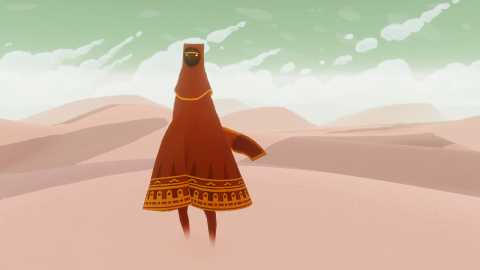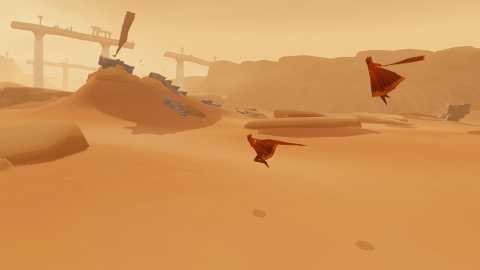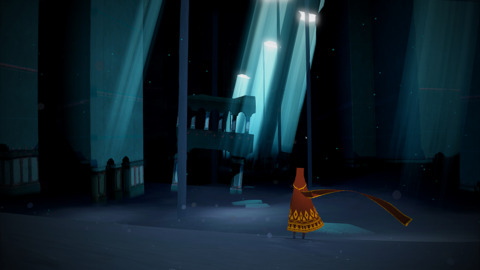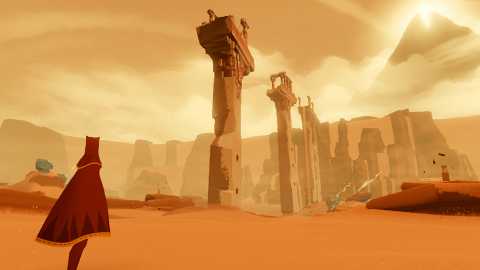When we talk about beauty in video games, more often than not we’re discussing it purely in the aesthetic sense. We’re talking about a game’s graphics, how pretty its art style is, and the like. Or maybe we’re discussing the soundtrack, referencing the aural beauty of a game’s music. This is more often the case than not simply because when we think of video games, we aren’t often able to point to more than a handful of experiences that truly affected us beyond the surface level emotions inherent to gaming: namely those of basic joy, humor, and all too often, frustration.

Journey, the latest game from indie development studio thatgamecompany, is certainly a game that offers up aesthetic beauty, both in its visuals and score. But where it truly shines is in the experience of playing it. In Journey, the mere acts of jumping, running, and sliding around a painstakingly crafted world are enough to invoke strong emotional responses from the player. Every element, every mechanic, every single little thing works in seemingly effortless concert to deliver a game that is experientially beautiful from surface to core.
Maybe that won’t be an altogether surprising thing to learn for those who have previously delved into the worlds imagined by thatgamecompany and its creative lead, Jenova Chen. In games like flOw and flower, Chen and crew have previously shown us gameplay concepts that blend traditional game mechanics with headier, less immediately tangible ideas of what a game environment can be. In that regard, Journey feels very much like a culmination of the studio’s previous work. It feels like the end result of many lessons learned, trials overcome, and ideas fully explored. It is confident in its design, and unwavering in its ambiguity. It is, quite simply, a masterpiece.
In Journey, you play as a nameless, nearly faceless creature of indeterminate origin. You’re decked in a robe that could be perceived as religious garb (or could just as easily just be a nicely decorated robe.) There is no real preamble to explain your character, where they came from, or why they find themselves standing in the middle of a vast, lonely desert. Nor do you get a particular explanation for why you are compelled to venture toward a distant mountain, with a peak that glows in a way that practically beckons you forward. All these details are left to the player’s imagination, perception, and interpretation.
All you do know is that you want to move forward, through that desert and toward that mountain. Initially, all you can do is walk. Soon, you’ll discover a cluster of reddish fabrics that look similar to the scarf that’s draped around your character’s neck. These fabrics turn out to be the fuel for your sole major ability in Journey. They give your character the power to leap and float through the air for limited periods of time. There is a sentient quality to these little swaths of cloth, especially later on as...well, I won’t spoil it for you.
That’s the tricky thing about trying to describe a game like Journey to someone. So much of its wondrous appeal comes from simply not knowing what to expect. Going in with less specific details is ideal, as knowing how your journey evolves over time before you’ve even taken it would rob that first time through of much of its awe-inspiring beauty. It is enough to simply say that the world around you evolves into more than just a desert. The terrain grows, both in scope and treacherousness as time goes on. Each “level” of Journey is comparatively unique, offering up something the player hasn’t yet seen before. Taking in that ever-evolving world without too much foreknowledge is not merely recommended; it’s necessary.

And yet, once you have finished it, the desire to go back and play again and again is there. Is the experience lessened by having already done it once before? Absolutely not. If anything, it’s heightened by the awareness of what’s to come, and the anticipation of seeing it all over again. The first time through, it’s crucial to be unsullied by too much information, but for subsequent plays, it won’t even matter.
It’s not that Journey varies itself up, or really changes at all from play to play. And yet there is one key difference, one unpredictable factor that never comes up the same way twice: multiplayer.
Yes, Journey has cooperative multiplayer, but not in the traditional sense we’ve come to expect from games in recent years. There is no matchmaking screen, no friend invite functionality, or even voice chat. Hell, you don’t even get a say in when the multiplayer becomes a factor. So long as your PlayStation 3 is online, at some point within the game, a second player, drawn randomly from the pool of other players making that very same journey, will simply appear alongside you. No, they don’t just drop in out of thin air. It’s more like you’ll turn a corner, and suddenly they’ll be standing there. Or you’ll jump off a ledge, and they’ll be waiting for you at the bottom. It’s a completely seamless transition.
But what does having two players actually do for the game? Mechanically, very little. There are no cooperative abilities to speak of, and no real communication between players to speak of. The sole mechanical benefit for working in tandem is that by standing close to one another, you can recharge each other’s jump ability to the fullest. As for communication, the sole way to get the other player’s attention is to use the “sing” ability, a single button press that causes your character to let out a solitary note. Normally this mechanic is used to charge up de-energized cloth pieces around the world, but when another player is around, it becomes a kind of de facto Morse code.
How you and your new-found companion choose to roll is entirely on each of you. You can stick together and experience the journey’s end arm-in-arm (or, in this case, I suppose scarf-in-scarf is more accurate), or you may split off at some point. The first time I played through Journey, my companion left nearly as soon as they had arrived, which allowed me to finish the game on my own. The second time, I made it a point to stick by my new friend, and they seemingly did the same.
It’s difficult to describe what, exactly, it is that makes the act of playing through Journey with another traveler so much better, but it really is. There is something deeply cathartic and moving about pushing through the late game’s obstacles together, looking out for one another as you climb, slide, and float past what pitfalls await you. Without giving much detail, I’ll simply say that there is a single shot at the very end of the game (one that you control) that is an emotionally joyous experience when you come to it on your own. And yet, when I got to that same place with my compatriot, that joy became something transcendental and overwhelming. They say the greatest journeys are those shared with others; this Journey would appear to prove that.

Perhaps some of you reading this might just shake your head at everything I’ve described thus far, mostly because I’ve described the game in largely superlative terms without really addressing the mechanics of the game itself, save but to say they are simple. Allow me to add that they are also effective, if that makes you feel any better. The greater point, however, is that you won’t really have to think of them. There aren’t many moments in Journey where you feel yourself concentrating on hitting the X button at a very specific time, or bemoaning the lack of jump energy currently at your disposal. Thoughts like that don’t enter your head because the core design simply doesn’t require them to.
You’re never so far from an energy boost that you’ll have to backtrack just to navigate an obstacle. You’re never “lost,” exactly, because the game is incredibly adept at showing you where you ought to be going, while allowing for a bit of exploration and discovery on your own. I don’t even recall dying at any point while playing Journey, though it is implied that you can. The easy accusation here, then, is that Journey is an incredibly easy game. That’s true, though perhaps an overly-simplified explanation.
Journey doesn’t hold your hand. It doesn’t tell you how you’re expected to play it, and that’s good. There’s no HUD to speak of. What little information you do need to know about how much damage you have left to take, and how much jump ability remains is right there on your character's scarf. It's part of the natural world you've entered, with no distracting HUD elements to ruin the immersion. What few bits of reality do seep their way into Journey are, quite frankly, unwelcome. Namely the initial controller tutorial, which seems almost carelessly tossed into a game world otherwise unsoiled by button prompts, life meters, and whatever else. Everything Journey does is entirely in service of keeping you specifically focused on your experience. It goes out of its way to ensure that the only thing you’re thinking about is the world that surrounds you, and that you, the player, are equally surrounded by it.
And it does a hell of a job, too. The visual art alone in Journey is enough to captivate those that play it. Its character and architectural art is of that gorgeous pseudo-religious style that’s informed everything from the modern day Legend of Zelda games to the works of Team Ico, and yet it remains distinctive and singular. It’s mesmerizing stuff, made even better by breathtaking lighting effects and a sound design that’s equal parts enrapturing and utterly unobtrustive. The score by composer Austin Wintory plays so perfectly into the emotional beats of the game world that it feels as much a part of the world as the ground you’re standing on. But again, it's these aesthetic elements working in tandem with Journey's design that truly sucks you into the game. Every single moment of Journey feels painstakingly crafted. There aren't bugs, glitches, or wonky physics issues to worry about. If you can find a polygon out of place in Journey, it's most likely because you went searching for it.

If there is a remaining quibble anyone might have, it will be Journey’s length, though I assure you this is an unnecessary nitpick. Yes, Journey is a fairly short game, clocking in at around two hours of total playtime. The thing of it is, if you’re going to think of Journey with the old idea of “dollar value divided by number of hours equals quality of experience” in mind, then you’re going about this all wrong. Journey is not a single serving game. It’s not meant to be played once and then abandoned. And while yes, the mechanics of it are quite simple, there is no reason you should even be thinking about those sorts of things while playing. If you’re even still aware that you’re holding a controller more than 15 minutes in, Journey may just not be for you.
Who is Journey for, then? It is for those that are able to lose themselves in the experience. That is perhaps a vague, nebulous recommendation, but that’s similarly the grand sum of Journey. It’s not a game you can easily pigeonhole into a specific genre or niche. There isn't an easy "if you like this, then you'll definitely like this" kind of comparison to be made. Perhaps the blandest description I can give for it is that it is a game made more to be felt and appreciated rather than simply consumed, as we so often tend to do with new games nowadays. Journey may be a game predicated on familiar mechanics and concepts, but what it does with them is something that borders on revelatory.